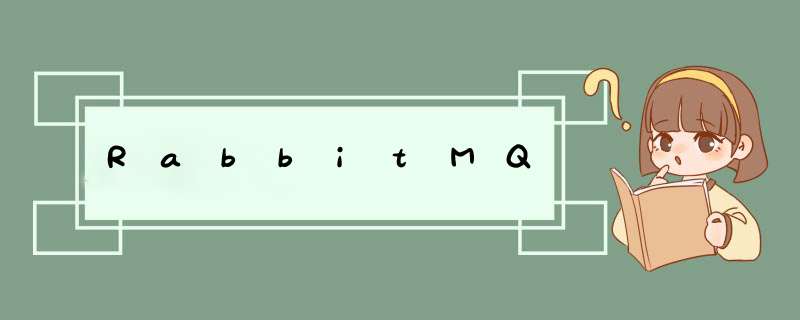
- 了解RabbitMQ的作用及架构
- 掌握RabbitMQ安装及基本使用
- 掌握Springboot整合RabbitMQ
1.2 什么是RabbitMQ1.降低耦合度
2.RabbitMQ速度快,微秒级别
3.学习成本低
4.支持多种语言
1.3 安装RabbitMQ
- RabbitMQ是一个由erlang开发的AMQP(Advanced Message Queue 高级消息队列协议)的开源实现
- 能够实现异步消息处理
#在线安装 docker pull rabbitmq:management #使用官方定义的端口号启动 docker run -d --hostname my-rabbit --name rabbit -p 15672:15672 -p 5672:5672 rabbitmq:management二.RabbitMQ架构 2.1官方简单架构图
2.2Rabbit完整架构图 2.3查看图形化界面并创建一个Virtual Host1.Publish-生产者(发布消息到RabbitMQ中的Exchange)
2.Exchange-交换机(与生产者建立连接并接收生产者的消息)
3.Routes-路由(交换机以什么样的策略消息发布到Queue)
4.Queue-队列(Exchange会将消息分发到指定的Queue,Queue和消费者进行交互)
5.Consumer-消费者(监听RabbitMQ中的Queue中的消息)
三.RabbitMQ使用 3.1RabbitMQ通讯方式 3.2 Java连接RabbitMQVirtual Host:相当于RabbitMQ上的虚拟机,建立connection连接的时Virtual Host!
创建一个全新的用户和全新的Virtual Host,并且将test用户设置上可以 *** 作/test-1的权限!
public static Connection getConnection(){
//创建Connection工厂
ConnectionFactory factory = new ConnectionFactory();
factory.setVirtualHost("/test-1");
factory.setPassword("test");
factory.setUsername("test");
factory.setHost("192.168.61.134");
factory.setPort(5672);
Connection connection = null;
//拿到连接
try {
connection = factory.newConnection();
} catch (IOException e) {
e.printStackTrace();
} catch (TimeoutException e) {
e.printStackTrace();
}
return connection;
}
3.3Hello-world
一个生产者,一个默认的交换机,一个队列,一个消费者
1、创建生产者,创建一个channel,发送消息到exchange,指定路由规则
//生产者
public static void publish() throws Exception {
//1、获取connection
Connection connection = RabbitConfig.getConnection();
//2、创建channel
Channel channel = connection.createChannel();
//3、发送消息到exchange
String msg = "hello world!!!";
channel.basicPublish("", "helloworld", null,msg.getBytes());
//PS:exchange是不会将消息持久化的,Queue可以持久化,得配置
System.out.println("生产者发布消息成功!");
//4、关闭管道和连接
channel.close();
connection.close();
}
2、创建一个消费者,创建一个channel,创建一个队列,并且消费队列
//消费者
public static void consumer() throws Exception{
//1、获取连对象、
Connection connection = RabbitConfig.getConnection();
//2、创建channel
Channel channel = connection.createChannel();
//3、创建队列-helloworld
channel.queueDeclare("helloworld",true,false,false,null);
//4.开启监听Queue
DefaultConsumer consumer = new DefaultConsumer(channel){
@Override
public void handleDelivery(String consumerTag, Envelope envelope, AMQP.BasicProperties properties, byte[] body) throws IOException {
System.out.println("接收到消息:"+new String(body,"UTF-8"));
}
};
channel.basicConsume("helloworld",true,consumer);
System.out.println("消费者开始监听队列");
//5、键盘录入,让程序不结束!
System.in.read();
//6、释放资源
channel.close();
connection.close();
}
3.4 Work
一个生产者,一个默认的交换机,一个队列,两个消费者
只需要在consumer消费者端,添加Qos能力以及更改为ACK手动即可让消费者根据自己的能力消费,不是RabbitMQ默认的平均分配了
//1指定当前消费者一次能消费多少条消息
channel.basicQos(1);
//2.开启监听Queue
DefaultConsumer consumer = new DefaultConsumer(channel){
@Override
public void handleDelivery(String consumerTag, Envelope envelope, AMQP.BasicProperties properties, byte[] body) throws IOException {
System.out.println("消费者1号接收到消息:"+new String(body,"UTF-8"));
try {
Thread.sleep(100);
} catch (InterruptedException e) {
e.printStackTrace();
}
//手动ACK(接收信息,指定书否批量 *** 作)
channel.basicAck(envelope.getDeliveryTag(),false);
}
};
//3.关闭自动ACK
channel.basicConsume("work",false,consumer);
3.5 Publish/Subscribe
一个生产者,一个交换机,两个队列,两个消费者
声明一个Fanout类型的exchange,并且将exchange和queue绑定在一起,绑定规则直接绑定。
1、让生产者创建一个exchange并且指定类型,和一个或多个队列绑定在一起。当生产者发送消息是会发送到exchange中,再由exchange到绑定的队列中
//3、通过channel创建自己的exchange 并且绑定队列
channel.exchangeDeclare("publish-exchange", BuiltinExchangeType.FANOUT);
channel.queueBind("pubsub-queue1","publish-exchange","");
channel.queueBind("pubsub-queue2","publish-exchange","");
3.6 Routing2、消费者还是监听指定队列即可。
一个生产者,一个交换机,两个队列,两个消费者
声明一个DIRECT类型的exchange,并且根据Routingkey绑定指定的队列
绑定生产者和消费者都可以做,因为两边都有channel
1、生产者在创建DIRECT类型的exchange后绑定相应的队列,并且指定Routingkey。在发送消息是也要指定消息的Routingkey
//3、创建exchange并且指定类型
channel.exchangeDeclare("routing-exchange", BuiltinExchangeType.DIRECT);
//4、绑定队列 routing-queue-error routing-queue-info
channel.queueBind("routing-queue-error", "routing-exchange", "ERROR");
channel.queueBind("routing-queue-info", "routing-exchange", "INFO");
//5、发送消息并且指定接收的队列的routingkey
channel.basicPublish("routing-exchange", "ERROR", null, "ERROR-MSG".getBytes());
channel.basicPublish("routing-exchange", "INFO", null, "INFO-1".getBytes());
channel.basicPublish("routing-exchange", "INFO", null, "INFO-2".getBytes());
channel.basicPublish("routing-exchange", "INFO", null, "INFO-3".getBytes());
3.7 Topics2、消费者没变化,监听自己的队列即可
一个生产者,一个交换机,两个队列,两个消费者
1、生产者创建Topic的exchange并且并且指定队列,这次绑定可以通过*和#匹配关键字,对指定RoutingKey内容进行匹配。
*(星号)可以代替一个单词。
#(哈希)可以替代零个或多个单词。
//3、创建exchange
channel.exchangeDeclare("topics-exchange", BuiltinExchangeType.TOPIC);
//4、绑定队列 topics-queue-1 topics-queue-2
channel.queueBind("topics-queue-1", "topics-exchange", "zhang.*");
channel.queueBind("topics-queue-2", "topics-exchange", "wang.*");
channel.queueBind("topics-queue-2", "topics-exchange", "wang.#;");
//3、发送消息到exchange
channel.basicPublish("topics-exchange", "zhang.sna", null, "张三".getBytes());
channel.basicPublish("topics-exchange", "zhang.sna.sna", null, "张三三".getBytes());
channel.basicPublish("topics-exchange", "wang.wu", null, "王五".getBytes());
channel.basicPublish("topics-exchange", "wang.ergou", null, "王二狗".getBytes());
System.out.println("生产者发布消息成功!");
四. Springboot整合RabbitMQ 4.1 helloword 模型 配置文件2、消费者无变化,监听指定的队列即可
spring:
# 配置虚拟主机
rabbitmq:
host: 127.0.0.1
port: 5672
username: test
password: test
virtual-host: /test
引入依赖
创建生产者4.0.0 org.springframework.boot spring-boot-starter-parent2.4.1 org.example demo11.0-SNAPSHOT 8 org.springframework.boot spring-boot-starter-weborg.springframework.boot spring-boot-starter-amqporg.springframework.amqp spring-rabbit-testtest org.springframework.boot spring-boot-starter-testtest org.junit.vintage junit-vintage-engineorg.springframework.boot spring-boot-maven-plugin
package com.ak.demo;
import org.junit.jupiter.api.Test;
import org.springframework.amqp.rabbit.core.RabbitTemplate;
import org.springframework.beans.factory.annotation.Autowired;
import org.springframework.boot.test.context.SpringBootTest;
import org.springframework.test.context.junit4.SpringRunner;
@SpringBootTest(classes = RabbitmqSpringApplication.class)
public class MyTest {
@Autowired
private RabbitTemplate rabbitTemplate;
@Test
public void test(){
rabbitTemplate.convertAndSend("hello","hello world");
}
}
创建消费者
package com.ak.demo.hello;
import org.springframework.amqp.rabbit.annotation.Queue;
import org.springframework.amqp.rabbit.annotation.RabbitHandler;
import org.springframework.amqp.rabbit.annotation.RabbitListener;
import org.springframework.stereotype.Component;
@Component
@RabbitListener(queuesToDeclare =@Queue("hello"))
public class HelloCustomer {
@RabbitHandler
public void kk(String message){
System.out.println(message);
}
}
目录结构
4.2 workquene 模型
修改work 类
@Test
public void test2(){
for(int i=0;i<10;i++){
rabbitTemplate.convertAndSend("work","work 模型");
}
}
创建消费者
package com.ak.demo.work;
import org.springframework.amqp.rabbit.annotation.Queue;
import org.springframework.amqp.rabbit.annotation.RabbitListener;
import org.springframework.stereotype.Component;
@Component
public class WorkConsumer {
@RabbitListener(queuesToDeclare =@Queue("work"))
public void receive(String messaage){
System.out.println("消费者1---"+messaage);
}
@RabbitListener(queuesToDeclare =@Queue("work"))
public void receive2(String messaage){
System.out.println("消费者2--"+messaage);
}
}
4.3 广播模式
创建生产者
@Test
public void test3(){
for(int i=0;i<10;i++){
rabbitTemplate.convertAndSend("kk","","广播信息");
}
}
创建消费者
package com.ak.demo.fanout;
import org.springframework.amqp.rabbit.annotation.Exchange;
import org.springframework.amqp.rabbit.annotation.Queue;
import org.springframework.amqp.rabbit.annotation.QueueBinding;
import org.springframework.amqp.rabbit.annotation.RabbitListener;
import org.springframework.stereotype.Component;
@Component
public class FanOutConsumer {
@RabbitListener(bindings = {
@QueueBinding(
value =@Queue,
exchange = @Exchange(value = "kk",type = "fanout")
)
})
public void receive(String message){
System.out.println("----");
System.out.println("广播信息1"+message);
}
@RabbitListener(bindings = {
@QueueBinding(
value =@Queue,
exchange = @Exchange(value = "kk",type = "fanout")
)
})
public void receive2(String message){
System.out.println("----");
System.out.println("广播信息2"+message);
}
}
4.4 直连模式
创建生产者
@Test
public void testDirect(){
String []routeKey={"error","info","waring","debug"};
for(int i=0;i<10;i++){
int temp=new Random().nextInt(100)%4;
rabbitTemplate.convertAndSend("directs",routeKey[temp],routeKey[temp]+"的日志信息");
}
}
创建消费者
package com.ak.demo.router;
import org.springframework.amqp.rabbit.annotation.Exchange;
import org.springframework.amqp.rabbit.annotation.Queue;
import org.springframework.amqp.rabbit.annotation.QueueBinding;
import org.springframework.amqp.rabbit.annotation.RabbitListener;
import org.springframework.stereotype.Component;
@Component
public class DirectConsumer {
String []routeKey={"error","info","waring","debug"};
@RabbitListener(bindings = {
@QueueBinding(
value = @Queue,// 临时队列
exchange = @Exchange(value = "directs",type = "direct"),
key={"error","info","waring","debug"}
)
})
public void receive(String message){
System.out.println("接受全部信息--"+message);
}
@RabbitListener(bindings = {
@QueueBinding(
value = @Queue,// 临时队列
exchange = @Exchange(value = "directs",type = "direct"),
key={"error"}
)
})
public void receive2(String message){
System.out.println("只接受error--"+message);
}
}
4.5 Topic 模式
创建生产者
@Test
public void testFive(){
String []routeKey={"user.save","user.add","admin.add","admin.save"};
for(int i=0;i<10;i++){
int temp=new Random().nextInt(100)%4;
rabbitTemplate.convertAndSend("topics",routeKey[temp],routeKey[temp]+"信息");
}
}
消费者
package com.ak.demo.topic;
import org.springframework.amqp.rabbit.annotation.Exchange;
import org.springframework.amqp.rabbit.annotation.Queue;
import org.springframework.amqp.rabbit.annotation.QueueBinding;
import org.springframework.amqp.rabbit.annotation.RabbitListener;
import org.springframework.stereotype.Component;
@Component
public class TopicConsumer {
@RabbitListener(bindings = {
@QueueBinding(
value = @Queue,
exchange = @Exchange(name = "topics",type = "topic"),
key={"user.*"}
)
})
public void receive(String message){
System.out.println("user类---"+message);
}
@RabbitListener(bindings = {
@QueueBinding(
value = @Queue,
exchange = @Exchange(name = "topics",type = "topic"),
key={"admin.*"}
)
})
public void receive2(String message){
System.out.println("admin 类--"+message);
}
}
欢迎分享,转载请注明来源:内存溢出

 微信扫一扫
微信扫一扫
 支付宝扫一扫
支付宝扫一扫
评论列表(0条)